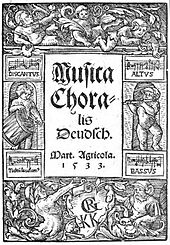Chorale

The word chant ( lat. Adjective choralis to gr. Χορός Choros "choir") originally designated in the liturgy of the Western Church unanimous church music , the even Gregorian chant called cantus Romanus . In the 14th century there was talk of the cantus choralis sive ecclesiasticus ("choral or church chant"), with choralis referring to the executing Schola . Choral music is so different from figural music . The word is used with this meaning in the Catholic area to this day .
In the 16th century the Protestant the language hymn melody in the vocal harmonies, the cantus firmus , Choral such as the named composers Johannes Eccard , Michael Praetorius and Samuel Scheidt .
Since the 18th century, the mostly four-part church song ( SATB ), with its melody and text, has been referred to as a chorale in Protestantism . This is also the name of the final stanza in cantatas and oratorios "Choral".
Organ arrangements of hymns are also called chorale ("organ chorale"). Occasionally, free organ pieces with chorale-like themes were also referred to by their composers as chorals (e.g. the “Three Choirs” by César Franck ).
In the 19th and 20th centuries, the term was also used within secular music for "sacred", church hymn-like passages and describes a diatonic , rhythmically simple, homophonically played melody movement, often played by brass (corresponding composers: Felix Mendelssohn Bartholdy , Johannes Brahms , Anton Bruckner , Gustav Mahler , Béla Bartók ).
See also
- Gregorian chant
- Form theory (music)
- History of the sacred song on the European continent
- Psalm (from Gr. Ψαλμός psalmós "string play, song")
literature
- Walter Blankenburg : Choral / Choral Singing . In: Theologische Realenzyklopädie 8 (1981), pp. 4-9
- Franz Karl Praßl : Choral. In: Oesterreichisches Musiklexikon . Online edition, Vienna 2002 ff., ISBN 3-7001-3077-5 ; Print edition: Volume 1, Verlag der Österreichischen Akademie der Wissenschaften, Vienna 2002, ISBN 3-7001-3043-0 .
- Catherine Winkworth : Lyra Germanica: The Christian Year. London 1861 Digitized text
Web links
- CPDL.org The Choral Public Domain Main Library ( ChoralWiki )
- Kantoreiarchiv.de scores of chorales by J. S. Bach (approx. 4500 PDF and MIDI files)
- The Cyber Hymnal , approx. 6200 chorals (text and MIDI files)
- Colmar hymnbook 365 chorales (text)
- Alsatian chorale melodies in the 19th century (text and MIDI files)
- Hymn books in Württemberg ( Memento from March 24, 2008 in the Internet Archive )
- Hymn books from areas outside Germany - mostly in German
- Sheet music for the hymnbook and for God's praise, for New Spiritual Songs (NGL) and praise song modern exposed for choir, band and (individual) instruments
- Hymns, Gospel Songs & Spirituals (text and MIDI files, sometimes sheet music as GIF)
- Collection of music, mainly church music from the 19th century (sheet music in the final format)